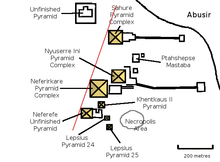Unfinished pyramid of Abusir
| Unfinished pyramid of Abusir | ||||||||||||||||||||
|---|---|---|---|---|---|---|---|---|---|---|---|---|---|---|---|---|---|---|---|---|
|
||||||||||||||||||||
The unfinished pyramid of Abusir is a royal tomb of the ancient Egyptian 5th dynasty in the necropolis of Abusir which was abandoned shortly after construction began . Schepseskare , a pharaoh about whom almost nothing is known and who is only attested to by a few seal impressions from the mortuary temple of Raneferef , is considered to be the builder .
exploration
The building was only discovered in the early 1980s by a Czech archaeological team led by Miroslav Verner , who found the leveled area and the pit. No other elements of the complex could be found.
Assignment
The pyramid construction site could not yet be directly assigned to any ruler, as the few finds did not contain any inscriptions. An indirect assignment to Schepseskare is based on the location of the construction site in the necropolis. From the proximity of the area to the pyramid of Sahure and the sun temple of Userkaf, Verner justifies his assumption that Sheepseskare belonged to the same branch of the royal family as these two rulers.
The chronological classification of the Schepseskare is not entirely clear. While Manetho lists him in the Aegyptiaca as the successor of Neferirkare , the finding of a seal imprint in the mortuary temple of Raneferef indicates that he was his successor and completed its mortuary temple. The chronological classification behind Raneferef is consistent with the fact that Raneferef could begin his construction in the same direction on Heliopolis , while his successor was no longer possible due to lack of space.
Construction circumstances
When Schepseskare came to power, the necropolis of Abusir was already built with three pyramids. With their north-west corners, these were probably aligned with the obelisk of Heliopolis ("Abusir diagonal"). In order to maintain this alignment, Schepseskare would have had to build his pyramid further into the desert than the unfinished Raneferef pyramid , which would have made it difficult to transport materials. Instead, he chose an area northwest of the Sahure pyramid halfway to the Userkaf solar sanctuary as a building site.
Schepseskare died after only a short period of reign, which led to the work being stopped. His successor Niuserre did not carry out any further work on this tomb. The place of Schepseskare's burial is unknown, but it can be assumed that he was not buried in the rudimentary tomb.
The pyramid
The construction of the actual pyramid body never started. Only the terrain to a square base was leveled. In the middle of the base there is a T-shaped pit in which the burial chamber and the access should be created.
The dimensions of the leveled area and the pit suggest that the building should have similar dimensions to the Neferirkare pyramid (105 m base length) and was therefore planned as the second largest tomb in Abusir after the Neferirkare pyramid. The exact dimensions can no longer be determined because the masonry had not yet started. The side inclination and thus the planned height cannot be determined due to a lack of cladding stones.
Remains of a pyramid complex consisting of the typical elements mortuary temple , enclosure wall, cult pyramid , access road and valley temple were not found. These components were probably never started as they would otherwise have hampered construction in the early construction of the pyramid.
literature
General
- Rainer Stadelmann : The Egyptian pyramids. From brick construction to the wonder of the world (= cultural history of the ancient world . Volume 30). 3rd, updated and expanded edition. Philipp von Zabern, Mainz 1997, ISBN 3-8053-1142-7 , p. 175.
- Miroslav Verner : The pyramids (= rororo non-fiction book. Volume 60890). Rowohlt, Reinbek bei Hamburg 1999, ISBN 3-499-60890-1 , pp. 345–346.
Excavation publications
- Miroslav Verner: A second unfinished pyramid in Abusir. In: Journal for Egyptian Language and Antiquity. (ZÄS) Vol. 109, 1982, pp. 75-78.
Individual evidence
- ↑ a b c d Rainer Stadelmann: The Egyptian pyramids. From brick construction to the wonder of the world. P. 175
- ↑ a b c d Miroslav Verner: The pyramids . Pp. 345-346
- ^ Miroslav Verner: Archaeological Remarks on the 4th and 5th Dynasty Chronology . In: Archive Orientální , vol. 69, Prague 2001, p. 396 ( PDF; 31 MB )
Coordinates: 29 ° 53 ′ 55 ″ N , 31 ° 12 ′ 6 ″ E
